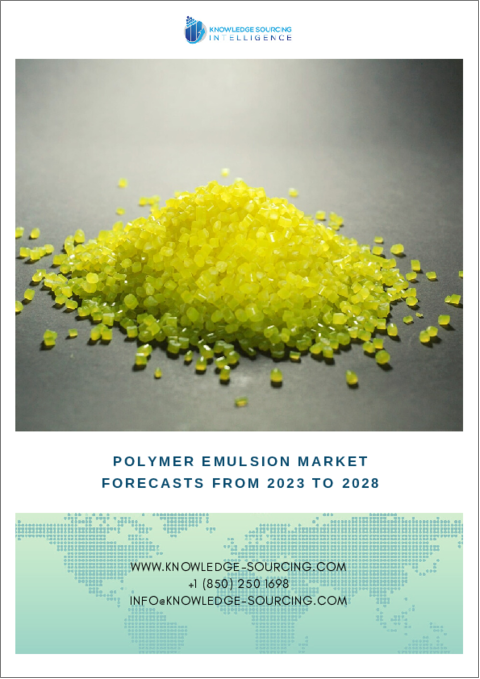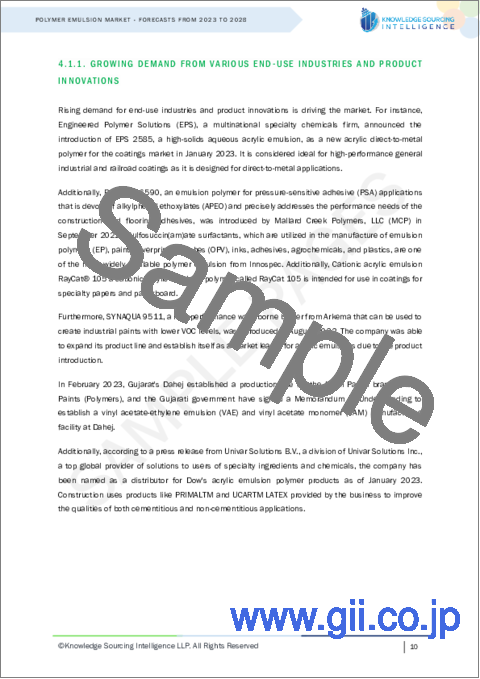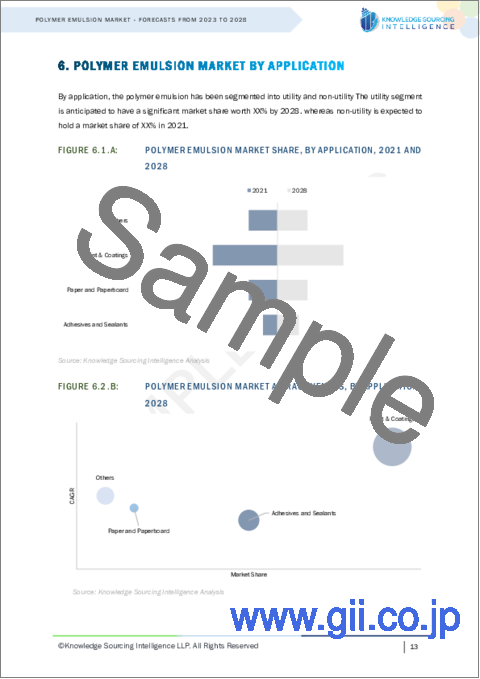|
|
市場調査レポート
商品コード
1279616
ポリマーエマルジョン市場-2023年から2028年までの予測Polymer Emulsion Market - Forecasts from 2023 to 2028 |
||||||
|
● お客様のご希望に応じて、既存データの加工や未掲載情報(例:国別セグメント)の追加などの対応が可能です。 詳細はお問い合わせください。 |
|||||||
| ポリマーエマルジョン市場-2023年から2028年までの予測 |
|
出版日: 2023年04月27日
発行: Knowledge Sourcing Intelligence
ページ情報: 英文 135 Pages
納期: 即日から翌営業日
|
- 全表示
- 概要
- 目次
ポリマーエマルジョン市場は、2021年の242億9,500万米ドルから2028年には410億3,700万米ドルに達し、CAGR7.78%で成長すると予測されています。ポリマーエマルジョンは、接着剤、塗料、コーティング剤、紙などの幅広い用途で広く使用されています。ポリマーエマルジョンは水性で、水中に分散したポリマーの小さな液滴から構成されています。これらの液滴は界面活性剤によって安定化され、合体するのを防ぐため、エマルションは安定で使い勝手が良くなっています。ポリマーエマルジョン市場は、様々な用途に使用される水性ポリマーの生産と流通に関わる成長産業です。ポリマーエマルジョンは、ポリマーの小滴を水中に分散させることで安定した混合物を作り、様々な用途に使用することができます。ポリマーエマルジョン市場は、幅広い用途や産業で使用される成長産業です。持続可能で環境に優しい製品への需要の高まりと、建設や自動車などの最終用途産業の成長は、世界のポリマーエマルジョン市場の継続的な成長を促進すると予想されます。
ポリマーエマルジョン市場は、建設、自動車、繊維、パッケージングなどのさまざまな最終用途産業からの需要の伸びと、環境に優しく持続可能な製品への需要の高まり別牽引されています。
- ポリマーエマルジョンの需要は、建設、自動車、テキスタイルなどの業界からの需要の高まり別牽引されています。ポリマーエマルジョンは、これらの産業において、コーティング剤、接着剤、シーラントなど幅広い用途で使用されています。米国地質調査所によると、ポリマーエマルジョンを含む合成ラテックスポリマーの米国での総生産量は、2020年には390万トンでした。これは前年比4%の増加を示しています。さらに、これはポリマーエマルジョンに関連する商品の出荷額の増加につながっています。米国国勢調査局によると、ポリマーエマルジョンを含む接着剤およびシーラントの出荷額は、2020年に123億米ドルであったと報告されています。これは、前年比5.6%の増加を示しています。環境問題への意識の高まりが、持続可能で環境に優しい製品への需要を後押ししています。ポリマーエマルジョンは、VOC排出量が少なく、無害であることから、従来の溶剤系製品の代替品として使用されることが多いです。
用途別では、ポリマーエマルジョン市場は、塗料・コーティング分野で積極的な成長が見込まれています。
ポリマーエマルジョン市場は、世界の塗料・コーティング産業の重要な構成要素となっています。ポリマーエマルジョンは、塗料の性能を高めるためのバインダーや接着剤として、塗料やコーティング剤に広く使用されています。耐水性、耐久性、密着性、光沢保持の向上などさまざまなメリットをもたらすため、多くの塗料やコーティング剤の配合に欠かせない成分となっています。ポリマーエマルジョン業界にとって重要な市場セグメントであり、高性能な水性塗料の需要の増加、建設業界や自動車業界の成長によって、今後も大きな成長が見込まれています。
ポリマーエマルジョン市場は、北米とアジア太平洋が大きなシェアを占めています。
北米では、米国がポリマーエマルジョンの最大市場となっています。同地域の建設産業の成長により、コーティング剤、接着剤、シーラント用のポリマーエマルジョンの需要が増加しています。さらに、同地域における水性コーティング剤や接着剤の需要の高まりが、市場の成長を促進しています。
アジア太平洋地域では、中国、インド、日本がポリマーエマルジョンsの最大市場となっています。これらの国々における建設業の成長と、水性塗料や接着剤の需要の増加が、市場の成長を促進しています。さらに、これらの国々における人口の増加や都市化がインフラ需要の増加につながり、ポリマーエマルジョンsの需要をさらに促進しています。
目次
第1章 イントロダクション
- 市場概要
- 市場の定義
- 調査範囲
- 市場セグメンテーション
- 通貨
- 前提条件
- 基準年と予測年のタイムライン
第2章 調査手法
- 調査データ
- 調査デザイン
第3章 エグゼクティブサマリー
- 調査ハイライト
第4章 市場力学
- 市場促進要因
- 市場抑制要因
- ポーターのファイブフォース分析
- 業界バリューチェーン分析
第5章 ポリマーエマルジョン市場:タイプ別
- イントロダクション
- アクリル
- 酢酸ビニル
- ポリウレタン(PU)ディスパージョン
- スチレンブタジエン(SB)ラテックス
- その他
第6章 ポリマーエマルジョン市場:用途別
- イントロダクション
- 接着剤およびシーラント
- 紙と板紙
- ペイントとコーティング
- その他
第7章 ポリマーエマルジョン市場:地域別
- イントロダクション
- 北米
- 米国
- カナダ
- メキシコ
- 南米
- ブラジル
- アルゼンチン
- その他
- 欧州
- ドイツ
- フランス
- 英国
- スペイン
- その他
- 中東・アフリカ
- サウジアラビア
- アラブ首長国連邦
- イスラエル
- その他
- アジア太平洋
- 中国
- 日本
- インド
- 韓国
- インドネシア
- 台湾
- その他
第8章 競合環境と分析
- 主要企業と戦略分析
- 新興企業と市場収益性
- 合併、買収、合意およびコラボレーション
- ベンダー競争力マトリックス
第9章 企業プロファイル
- Gellner Industrial LLC
- Celanese Corporation
- Arkema
- Akzo Nobel N.V.
- BASF SE
- Synthomer PLC
- DOW
- Wacker Chemie AG
- Accepta Water Treatment
The polymer emulsion market is projected to grow at a CAGR of 7.78% to reach US$41.037 billion in 2028 from US$24.295 billion in 2021. Polymer emulsion is used extensively in a wide range of applications such as adhesives, paints, coatings, and paper. Polymer emulsions are water-based and consist of small droplets of polymer dispersed in water. These droplets are stabilized by surfactants that prevent them from coalescing, which makes the emulsion stable and easy to use. The polymer emulsion market is a growing industry that involves the production and distribution of water-based polymers that are used in a variety of applications. Polymer emulsions are created by dispersing small droplets of a polymer in water, which creates a stable mixture that can be used in many different applications. the polymer emulsion market is a growing industry that is used in a wide range of applications and industries. The increasing demand for sustainable and eco-friendly products, coupled with the growth of end-use industries such as construction and automotive, is expected to drive continued growth in the global polymer emulsion market.
The polymer emulsion market is driven by growing demand from various end-use industries such as construction, automotive, textiles, and packaging as well as increased demand for eco-friendly and sustainable products.
- The demand for polymer emulsions is being driven by the growing demand from industries such as construction, automotive, and textiles. Polymer emulsions are used in a wide range of applications in these industries, including coatings, adhesives, and sealants. According to the United States Geological Survey, the total US production of synthetic latex polymers, which includes polymer emulsions, was 3.9 million metric tons in 2020. This represents an increase of 4% from the previous year. Additionally, this has led to an increase in the value of shipments for goods associated with polymer emulsions. The US Census Bureau reports that the value of shipments of adhesives and sealants, which include polymer emulsions, was US$12.3 billion in 2020. This represents an increase of 5.6% from the previous year.
- The increasing awareness of environmental issues is driving the demand for sustainable and eco-friendly products. Polymer emulsions are often used as a replacement for traditional solvent-based products, as they have lower VOC emissions and are non-toxic.
Market Developments
- In January 2023, Engineered Polymer Solutions (EPS), a global specialty chemicals company, announced the launch of a new acrylic direct-to-metal polymer for the coatings market called EPS 2585, a high-solids waterborne acrylic emulsion. It has the capability to be formulated for direct-to-metal applications, making it ideal for high-performance general industrial and railcar coatings. The polymer offers excellent hardness, block resistance, and early water resistance. EPS has developed the polymer to meet the market requirements, striking the perfect balance of properties. The new polymer optimizes the coating process by eliminating the priming step, which helps manufacturers save time and money, while also extending the life of coated products. The product is well-suited for exterior applications due to its exceptional gloss retention and multi-substrate adhesion.
- In September 2022, Mallard Creek Polymers, LLC (MCP) launched Rovene® 6590, an emulsion polymer for pressure-sensitive adhesive (PSA) applications that is free of alkylphenol ethoxylates (APEO) and specifically targets the construction and flooring adhesives' performance requirements. Rovene 6590 is an acrylic polymer with a low glass transition temperature (-41°C) and high solids content (61%), boasting excellent peel/loop tack and shear balance, with consistent peel increase over a 24-hour period. It is also formulated for enhanced adhesion to low surface energy substrates, particularly polyolefin-based substrates. The product has shown exceptional performance in flooring adhesive applications, with demonstrated resistance to alkali water and plasticizers. It also requires less thickener and offers good mechanical stability, allowing it to be effectively formulated to increase its viscosity and incorporate fillers.
Based on application, the polymer emulsion market is expected to witness positive growth in the paint and coatings segment.
The polymer emulsion market is a significant component of the global paint and coatings industry. Polymer emulsions are widely used in paints and coatings as a binder or adhesive to enhance the performance of the coating. They provide various benefits such as improved water resistance, durability, adhesion, and gloss retention, making them an essential component of many paint and coating formulations. It is a crucial market segment for the polymer emulsion industry, and it is expected to continue to witness significant growth in the coming years, driven by the increasing demand for high-performance, water-based coatings and the growth of the construction and automotive industries.
North America and Asia Pacific account for major shares of the polymer emulsion market.
In North America, the United States is the largest market for polymer emulsions. The growth of the construction industry in the region has led to an increase in demand for polymer emulsions for coatings, adhesives, and sealants. Additionally, the growing demand for water-based coatings and adhesives in the region is driving the growth of the market.
In the Asia-Pacific region, China, India, and Japan are the largest markets for polymer emulsions. The growth of the construction industry in these countries, coupled with the increasing demand for water-based coatings and adhesives, is driving the growth of the market. Additionally, the increasing population and urbanization in these countries are leading to a rise in demand for infrastructure, further driving the demand for polymer emulsions.
Market Segmentation
By Type
- Acrylic
- Vinyl Acetate
- Polyurethane (PU) Dispersion
- Styrene Butadiene (SB) Latex
- Others
By Application
- Adhesives and Sealants
- Paper and Paperboard
- Paint & Coatings
- Others
By Geography
- North America
- USA
- Canada
- Mexico
- South America
- Brazil
- Argentina
- Others
- Europe
- Germany
- France
- United Kingdom
- Spain
- Others
- Middle East And Africa
- Saudi Arabia
- UAE
- Israel
- Other
- Asia Pacific
- China
- Japan
- India
- South Korea
- Indonesia
- Taiwan
- Others
TABLE OF CONTENTS
1. INTRODUCTION
- 1.1. Market Overview
- 1.2. Market Definition
- 1.3. Scope of the Study
- 1.4. Market Segmentation
- 1.5. Currency
- 1.6. Assumptions
- 1.7. Base, and Forecast Years Timeline
2. RESEARCH METHODOLOGY
- 2.1. Research Data
- 2.2. Research Design
3. EXECUTIVE SUMMARY
- 3.1. Research Highlights
4. MARKET DYNAMICS
- 4.1. Market Drivers
- 4.2. Market Restraints
- 4.3. Porter's Five Forces Analysis
- 4.3.1. Bargaining Power of Suppliers
- 4.3.2. Bargaining Power of Buyers
- 4.3.3. Threat of New Entrants
- 4.3.4. Threat of Substitutes
- 4.3.5. Competitive Rivalry in the Industry
- 4.4. Industry Value Chain Analysis
5. POLYMER EMULSION MARKET BY TYPE
- 5.1. Introduction
- 5.2. Acrylic
- 5.3. Vinyl Acetate
- 5.4. Polyurethane (PU) Dispersion
- 5.5. Styrene Butadiene (SB) Latex
- 5.6. Others
6. POLYMER EMULSION MARKET BY APPLICATION
- 6.1. Introduction
- 6.2. Adhesives and Sealants
- 6.3. Paper and Paperboard
- 6.4. Paint & Coatings
- 6.5. Others
7. POLYMER EMULSION MARKET BY GEOGRAPHY
- 7.1. Introduction
- 7.2. North America
- 7.2.1. USA
- 7.2.2. Canada
- 7.2.3. Mexico
- 7.3. South America
- 7.3.1. Brazil
- 7.3.2. Argentina
- 7.3.3. Others
- 7.4. Europe
- 7.4.1. Germany
- 7.4.2. France
- 7.4.3. United Kingdom
- 7.4.4. Spain
- 7.4.5. Others
- 7.5. Middle East And Africa
- 7.5.1. Saudi Arabia
- 7.5.2. UAE
- 7.5.3. Israel
- 7.5.4. Other
- 7.6. Asia Pacific
- 7.6.1. China
- 7.6.2. Japan
- 7.6.3. India
- 7.6.4. South Korea
- 7.6.5. Indonesia
- 7.6.6. Taiwan
- 7.6.7. Others
8. COMPETITIVE ENVIRONMENT AND ANALYSIS
- 8.1. Major Players and Strategy Analysis
- 8.2. Emerging Players and Market Lucrativeness
- 8.3. Mergers, Acquisition, Agreements, and Collaborations
- 8.4. Vendor Competitiveness Matrix
9. COMPANY PROFILES
- 9.1. Gellner Industrial LLC
- 9.2. Celanese Corporation
- 9.3. Arkema
- 9.4. Akzo Nobel N.V.
- 9.5. BASF SE
- 9.6. Synthomer PLC
- 9.7. DOW
- 9.8. Wacker Chemie AG
- 9.9. Accepta Water Treatment




